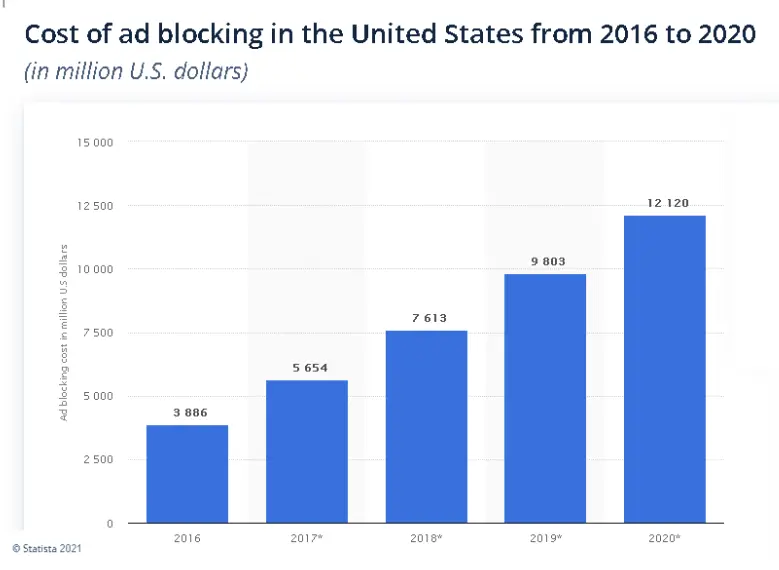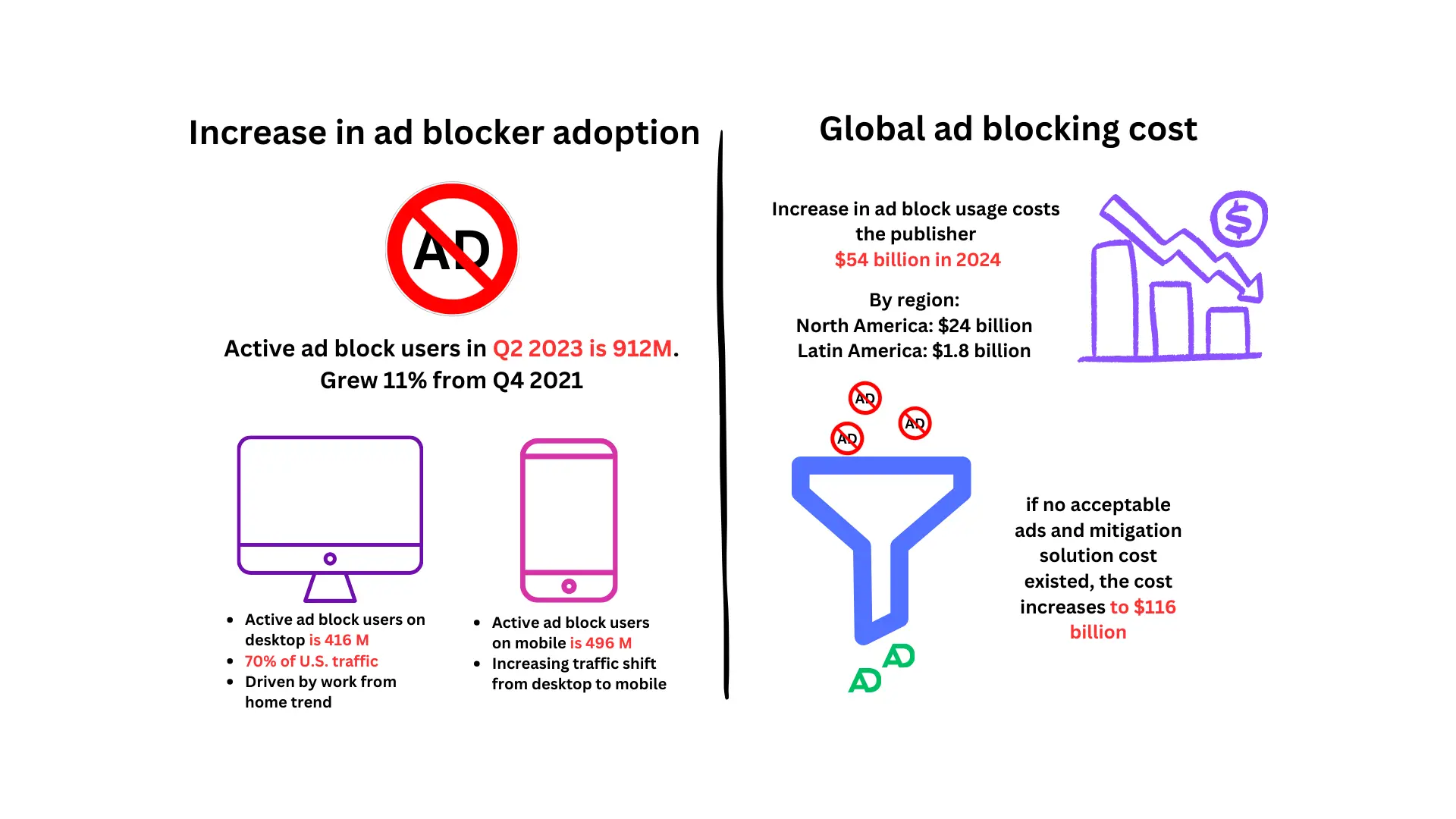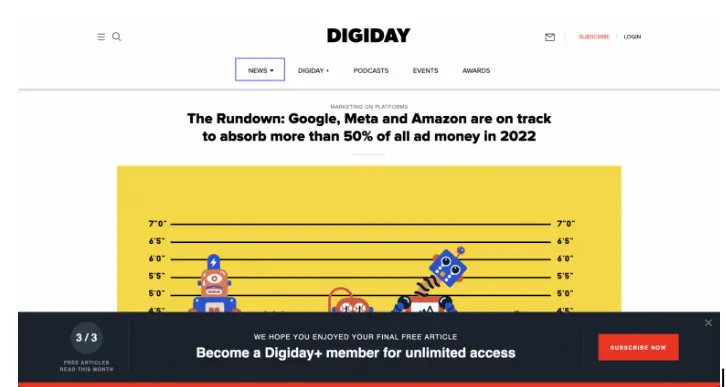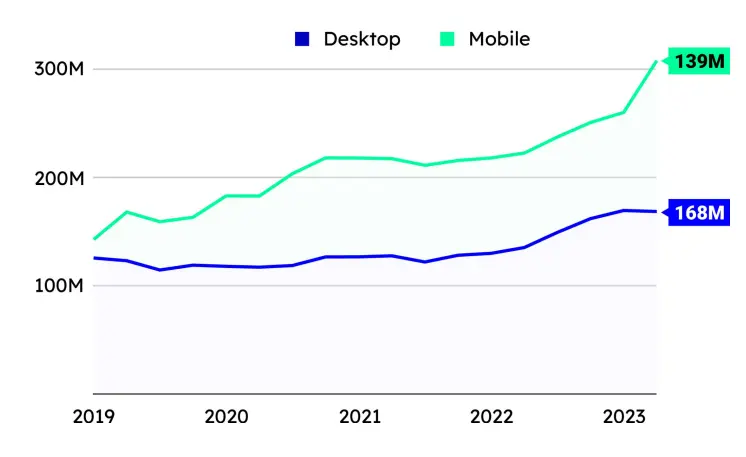Rise in ad blocker usage rate, loss in revenue!
It is a love-hate relationship, and publishers and advertisers equally suffer.
Are you one among them? Then you are in the right place.
The rise in the adoption of ad blockers cost publishers $12 billion in 2020. The rate of revenue loss is $3 billion per year. According to Backlinko, 47% of internet users used ad blockers in 2023.

These are not easy numbers to cross. Hence, you must fight back by encouraging users to reduce ad-blocker usage with these handpicked strategies and regain your lost revenue. As a publisher, this must not be new to you. You might already be executing a couple of them.
But the problem here is, are they working? Are they helping in reliable ad block recovery? Are they getting your revenue back?
You need to ask yourself these questions while choosing or assessing strategies. Here, we have covered innovative ad block recovery solutions that give answers to these questions.
Additionally, we have denoted reliable examples of thought leaders using these strategies and seeing revenue improvements. So, get ready to learn actionable tips and insights.
I assure! You will not find any boring strategies like “write good content,” “reduce ad density,” or “ improve user experience.”
Table of Contents
Ad Block: What Is It & How Does it Work?
Ad block, commonly referred to as ad blocker, is a technology that prevents ads from being displayed on a webpage or app, both on desktop or mobile. Users commonly use ad blockers in the form of web plugins, browser extensions, and hardware.
- Ad blockers prevent all ad formats like display, native, and video ads. It also blocks third-party tracking like ad targeting, measurement, and analytics.
- They work by listening to all HTTP calls on the website. It compares each request against the blacklist or filter list using regular expressions* (regex).
*Blacklist contains the domains, URLs, links, and HTTP calls sent to known ad servers or platforms to fetch ads. Regex is a pattern-matching technique that matches the ad calls in the website with the filter list to block them.
For instance, if an ad blocker finds an ad request sent to a known ad network or ad server like Google Ad Manager (GAM), it blocks that. Further, it prevents the network from completing it, so the ad creative will not load.
Why You Should Care About Ad Block?
It is obvious. Isn’t it? As a publisher relying on website monetization, you must care about it to regain your revenue source.
Eyeo, the ad filtering technology group, and its subsidiary Blockthrough released an ad blocking rate report in January 2024. This report shows a higher degree of ad blocker adoption and impact on publisher revenue.

The prediction of global ad blocking cost is $54 billion with ad filtering* and $116 billion without ad filtering. This shows that the ad blocking rate is not going to slow down. Hence, prepare yourself with competent strategies to reduce ad blocking rate on your website to get your money back.
*Ad filtering is the process of users allowing relevant and non-intrusive ads.
Bypass Ad Blockers with Unique Approaches
Update page code frequently
Ad blockers closely monitor the calls and requests going in and out of the site to find ad elements that match their blacklist. They almost always use the same pattern to detect ad-related page elements.
So, updating the page code frequently makes it hard for ad blockers to detect ads and ad-associated calls consistently.
- You can regularly change the class and ID names* associated with ad elements. If you do so, it might take a while for ad blockers to infer the change and act.
*Class names and ID names are attributes utilized in HTML and CSS to identify and style web page elements.
- You can also minify or obfuscate (encrypt or make unclear) code to make it hard for ad blockers to find the ad-related elements. It includes shortening the variable names, removing whitespace, and obfuscating the JavaScript functions.
The PageFair executives believe that ad blocking software is easy to bypass. They update the code regularly to force the ad block community to work from scratch again.
Give the option to ad-light experience
These days, many publishers use ad-light experience. This approach persuades users to turn off the ad block for an ad-light experience and access quality content. Forbes follows this innovative approach; they promise an ad-light experience to their users who disable the ad block.
The ad-light experience removes the elements that annoy the users and only shows relevant ads. In its reader compliance, Forbes says it will not show pop-up ads, video ads in between paragraphs, and no ads between posts.
Whoever denies the ad-light experience will be denied access to see the content.
Anti-ad block walls or paywalls
This process comprises implementing a paywall either to make money for using content or in exchange for turning off the ad blockers.
First, insert an anti-ad blocker script in your page code. It detects ad blockers once the users enter the site so you can stop the content serving and show paywalls accordingly.
There are two kinds of paywall. Each is suited to different kinds of publishers, small, mid-market, or enterprise.
Hard paywalls: Hard paywalls strictly demand users to turn off ad blockers or pay to see the content.
Strict denial of service: The user will be given two strict choices – to disable the ad blocker or to pay.
Redirections: The user will be directed to the page explaining how ads are fuelling the page revenue if they are not turning off ad blockers or subscribing. But again, redirections lead to a bad user experience. So, for these reasons, this paywall is not suggested.
Soft paywall: The soft paywall gives users limited access to content before asking them to disable ad blockers or subscribe. A soft paywall can be shown in different ways.
- Lightbox pop-ups to tell users to turn off ad blockers for some time or ask them to pay
- Consent walls to ask users to allow acceptable ads or ask them to subscribe to see the content.
- Lenient paywalls allow users to access limited free content for a week or month. Above that, they have to pay. A great instance of this is Digiday.
Digiday offers three free articles per user for a month. If the limit goes off, it shows a paywall for users to subscribe.

- Dimming the content after the user reaches the middle of the page and asking them to pay or turn off the ad block to access the content.
It might invoke users to disable it if they are into the content and stopped mid-way. However, this paywall is not suitable for sites with high bounce rates.
Other revenue streams:
Showing ads is not the only revenue stream for publishers; you can start a subscription.
You must have seen subscription paywalls on sites of enterprise publishers like the Financial Times. Yes, it is a paywall that asks you to subscribe to the page to access content.

While the adoption of ad blocks is on the rise, using subscriptions is another way to generate revenue. However, it might be difficult to scale and can be only suitable for thought leader sites.
Apart from subscriptions, you can also post sponsored content. An ad blocker cannot identify it. Also, you can earn extra revenue from it.
Use rewarded video ads
Rewarded video ads are a mutual benefit for both users and publishers, where users will be awarded something valuable in exchange for seeing video ads. These rewarded video ads are mostly suitable for gaming. You can give in-app awards like extra life, new weapons, or game currency to users for seeing ads.
This strategy persuades users to turn off ad blockers and lets you get high ad views. Imagine the cost of viewable impressions of video ads. It is highly lucrative.
Coalition for Better Ads Standards
Better ad standards define the ad experience that falls short in user acceptability, which is more likely to drive them to adopt ad blockers.
Following this standard helps you cross a few ad blockers like Google Chrome’s inbuilt ad blocker, Adblock Plus, and Ublock Orgin. Eventually, you will not lose revenue to the users who use these ad blockers.
Chrome also has an ad experience report tool that lets you check the problems on the website and with ads.
Hence, following this standard is one of the best and most legitimate ad block recovery mechanisms.
Acceptable ads
Acceptable ads are the most viable ad block recovery solution. It bridges the gap between positive user experience and ad monetization.
The Acceptable Ads Initiative was started by Eyeo, the organization that launched AdBlock Plus. The standards are formed for and by ad blocker users based on their browsing experience.
According to the ad filtering report by Eyeo, the acceptable ads achieved an average adoption rate of 94% from Q1 2022 to Q2 2023.
The adoption rate by desktop is 168M, and by mobile, it is 139M.

Hence, using acceptable ads seems a potential solution for bypassing ad blockers to get back your revenue. Most importantly, to develop a positive user experience as this is the most viable approach to use.
Server-side ad insertion
Server-side ad insertion is mainly the option to prevent video ads from getting blocked. This approach dynamically stitches the video ad into content before streaming it to the users.
When you implement a client-side ad insertion, the video ad will be served from the content server whenever the user requests it, and the ad server will serve the ad. The content and ad will be combined on the website and streamed to the user. The ad calls sent in and out of the website are highly likely to get caught by ad blockers.
In server-side ad insertion, the ad server checks the ad breaks in the video content before it gets streamed to users. Further, it will decide which ads to display based on the user information. Once decided, the ad will be dynamically stitched into the content and streamed to the users.
Here, the ads will be seamlessly integrated into the content stream and become a part of the video itself.
So finally, when the video plays, everything plays in one stream, like watching ads on Television. You will get high viewable impressions.
Adblockers usually cannot differentiate the content and ads when stitched together. This allows you to bypass the ad blockers easily.
Using server-side ad insertion might be effective in some way, but the ads delivered have the chance to be ignored. Ignored, in the sense that the ads are running, but users are not engaging with that. Hence, ad performance tracking will become quite difficult.
Use native ads
According to the Association of Online Publishers (AOP), publishers need to show ads that are less annoying in the first place. Native advertising fits that criteria very well.
These ads are less intrusive than ad formats like pop-ups and banner ads. Most importantly, it is harder for ad blockers to detect.
Due to these reasons, many publishers are ditching display ads to go for native ads. According to the study, the ad spending rate of native ads will jump 372% between 2020 and 2025. The market value of native advertising will be $400 billion by 2025, with the U.S. being the largest market ($139.5 billion).
Pick the right monetization partner
While researching, you can pick out many wise strategies and technologies to fight ad block. But the real pain stays in executing those techniques in the right way to get better results. It is not easy until you have an expert adtech monetization partner.
The right partner would have experience handling adblockers. They have the working knowledge of the right ad sizes, placement, and layout that pleases users and uplifts user experience.
So, find a partner who has their exclusive ad block recovery solution with enough experience and expertise. We understand how tricky it could be to find a partner that fits the bill. And that’s precisely why you should connect with us.
We could help you find the right partner. The one evaluated on the choicest parameters for its best ad recovery solution.
How to Start Bypassing Ad Blockers?
Feels like you are ready to fight back? Well, the first task is always analyzing the impact and source.
So first, measure the impact of increased adoption of ad blockers on your ad revenue. Find how much you have lost, what percent of your traffic uses ad blockers, traffic from which country mostly uses ad blockers, etc.
These statistics give you insights about which strategy would best suit your website.
For instance, if you find the U.S. audience using ad blockers the most on your website. You can customize the anti-ad block wall specific to them. You can also give rewards in exchange for turning off ad blockers. Personalized recovery solutions work wonders in retrieving lost revenue.
Beat Ad Block with Better Strategies
Testing and Optimization is the basic block!
Testing comprises running trials and experiments to test the strategies. Optimization comprises the process of making improvements and adjustments to the testing results.
So, whatever strategies you choose from this list, the idea is to do rigorous testing. This will let you assess their impact on your website’s user and ad experience. Simultaneously, optimize to find the combination of strategies that reflect positively on your bottom line.
By doing so, you can easily bypass most of the adblockers to keep your revenue flowing. Above all, you can make your website a most-user loved one.























